MDMA
(Molly, Ecstasy, E, XTC)
TrippyWiki score: 7.6/10
TABLE OF CONTENTS
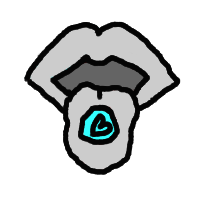
What is MDMA?
MDMA is an entactogen of the amphetamine class. It is one of the most popular drugs of our time, being used both for recreational and healing purposes. Thanks to the work of Rick Doblin and other scientists, MDMA will soon be legalized for its therapeutic effects.
Why choose MDMA over other psychedelics?
MDMA…
Long-term benefits & side effects
Many of the benefits will only occur if you follow the tips below.
Most (if not all) of the side effects are preventable and they will not happen if you follow the Safety checklist.
MDMA…
How to take MDMA
Pills vs. Powder
MDMA mainly comes in 2 forms: powder and pill form (Ecstasy).
Taking a pill is not recommended for 2 reasons:
1) The pills are notoriously cut with other drugs that are cheaper to produce (methamphetamine is a common substitute).
2) The amount of MDMA in a pill varies greatly. An average pill sold on the street has on average 150 mg of MDMA but it can contain as little as 50 mg or as much as 300 mg.
Whichever form you choose, always test your substance with a Marquis Reagent Testing Kit. If the substance turns black, you most likely have real MDMA.
If you take a pill form, start smaller than you would because you cannot know how much MDMA is in there.
Administration
The substance is either snorted or taken orally. You could also inject MDMA or plug it but these methods are not recommended.
Snorting MDMA will lead to a faster onset but has multiple risks associated with it. This is why the best way to consume the drug is to swallow it.
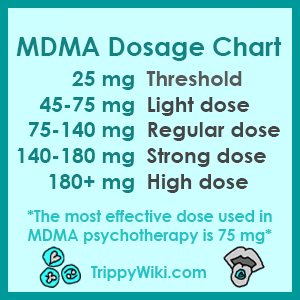
Dosage
75 mg seems to be the best dose to take if you are taking MDMA for long-term benefits.
Unlike with LSD or magic mushrooms, there is no correlation between mystical experiences and therapeutic effects when it comes to MDMA.
The benefits of 75 mg are as big as they can get while the negatives are multiple times smaller than if you were to take higher doses.
High doses of MDMA can be lethal. A teenage girl died after taking just 500 mg and she did not mix the drug with any other substance.
With that said, overweight people or those with autism need a higher dose to achieve the same effects.
The same can be said about people who have been taking Molly in the past since it can take multiple months to become sensitive to the substance again.
Safety checklist
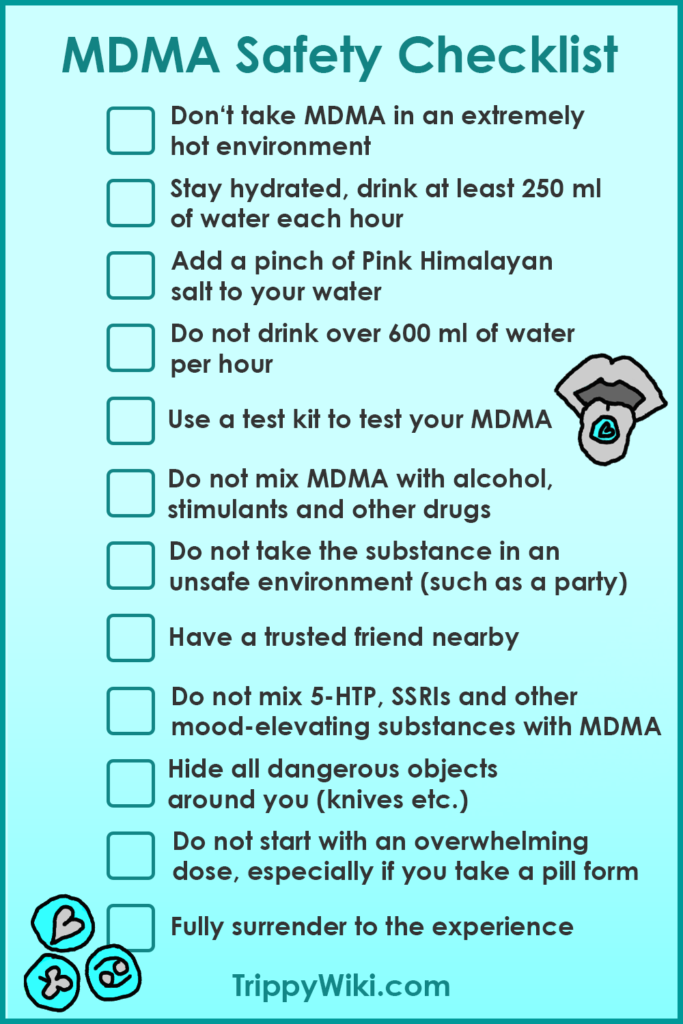
Maximize the benefits
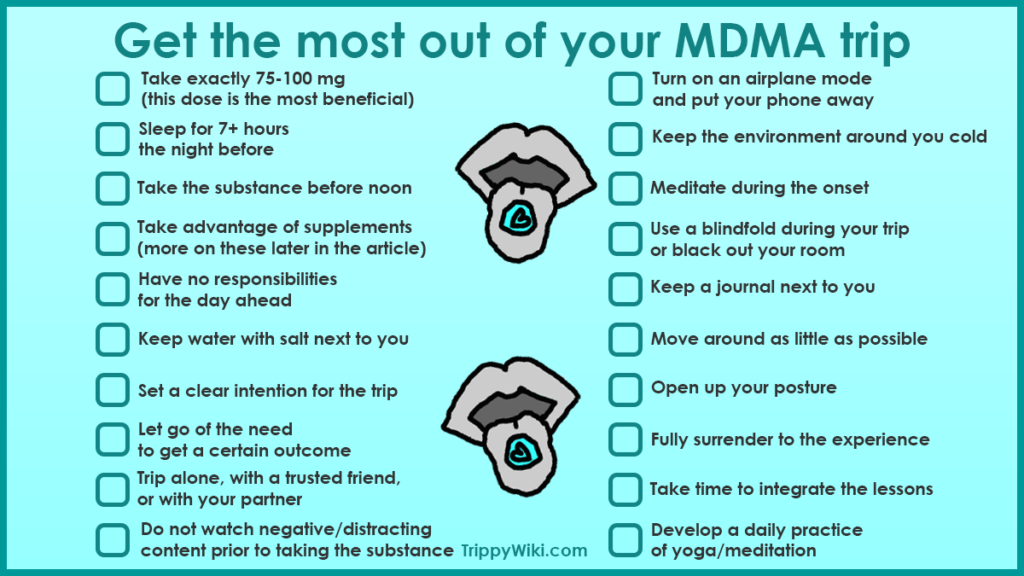
Keep in mind that integration is even more important than the trip itself. Taking psychedelics would be almost useless if you didn’t retain any lessons in your day-to-day life.
What will help you the most is contemplating about the experience – be it by journaling, thinking about the trip, or sharing your memories with a trusted friend.
Distracting thoughts can get in the way, which is why you want to spend the day after your trip without TV, social media, and other distractions.
If you can, spend time in silence and solitude. Meditate, go for a walk, contemplate the experience.
Duration
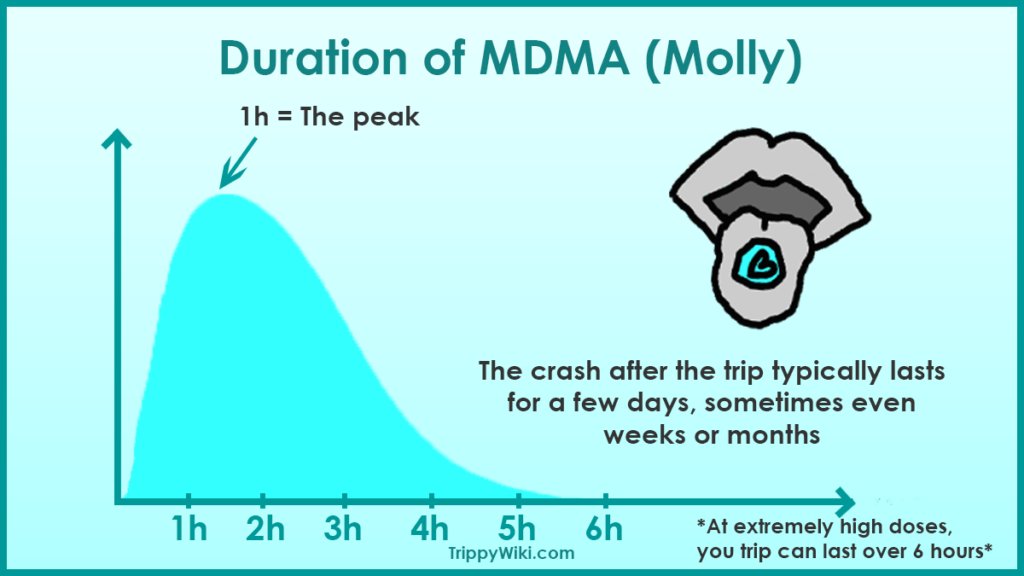
Onset = 30-60 minutes
Come up = 15-30 minutes
Peak = 90-150 minutes
Offset = 1-2 hours
What does MDMA feel like?
After you take the drug, your brain releases dopamine, serotonin, oxytocin, norepinephrine, and other happy chemicals. This is why the experience tends to be extremely pleasant.
On MDMA, it is common to feel extreme euphoria, love, compassion, connection with everything and everyone, and every other positive feeling you can imagine. You will feel like everything is perfect.
People become way more social and talkative on MDMA. Because of this, the drug is a powerful tool for treating social anxiety and even autism.
The downside is that you may share some secrets with people around you that you will later regret. You may also end up in bed with a stranger who has an STD.
In therapy, the MDMA experience isn’t always pleasant. In fact, most participants describe the experience as challenging.
MDMA can make you anxious but this mainly happens during a come-up. After that, the anxiety usually dissolves.
Other common short-term effects include:
Higher self-esteem
Tingling sensation
Increased creativity and open-mindedness
Mindfulness, being present
Higher capability for love and compassion
Pain relief
Feeling one with all that is
Seeing life from a different perspective
Appreciating small things
Higher energy
Increased awareness
Stamina enhancement
Feeling your emotions more intensely
Memory suppression
Time distortion (time speeds up)
Visual effects (especially during the offset)
No appetite
Shaking
Jaw clenching
Headaches
Muscle tension
Fatigue
Inability to focus
Nausea, vomiting
Increased body temperature
Increased heart rate
Worse thermoregulation
Difficulty urinating
Anxiety, paranoia
Vulnerability
Insomnia
The higher dose you take, the more intense these effects will be.
After the trip, some users find it difficult to fall asleep.
MDMA will almost always give you a pleasant experience. Bad trips can happen but you can prevent them by following the tips below.
After the trip, there is a chance that you will experience an afterglow or a crash, also called MDMA comedown.
MDMA Comedown
After the trip, your brain will be depleted of serotonin, dopamine, and norepinephrine. When this happens, you may have to suffer through a period of not having enough of these happy chemicals.
During the crash, people feel extremely depressed and have no motivation to do anything. Many MDMA users report having suicidal thoughts.
This period usually lasts a few days but can sometimes take weeks or even months.
How to prevent a comedown
In a psychotherapeutic setting, MDMA crash only happens to 30% of participants and is very mild. If you don’t follow these rules, the chance will be much higher and the crash will be longer and a lot more unpleasant.
How to cope with a comedown
Bad trips
Bad trips mostly happen because people take the substance irresponsibly. If you take this psychedelic the right way, there is virtually no chance you’ll get a bad trip.
In case you still do, that’s good! A “bad” trip isn’t bad, it can actually be the most healing and insightful moment of your life!
During a “bad” trip, negative emotions are coming up from your subconscious mind. They have always been there whether you are aware of it or not. They have been damaging your life and a difficult trip is an opportunity to process these traumas and unpleasant feelings and let go of them.
The more painful the experience, the more you can heal.
So instead of calling bad trips bad, call them challenging.
If you understand that bad trips are awesome in the long run, not only will you feel more comfortable diving into these challenging states, it will actually excite you!
Why they happen
The most common reasons for getting a bad trip are:
How to cope with a bad trip
Interactions
History of MDMA
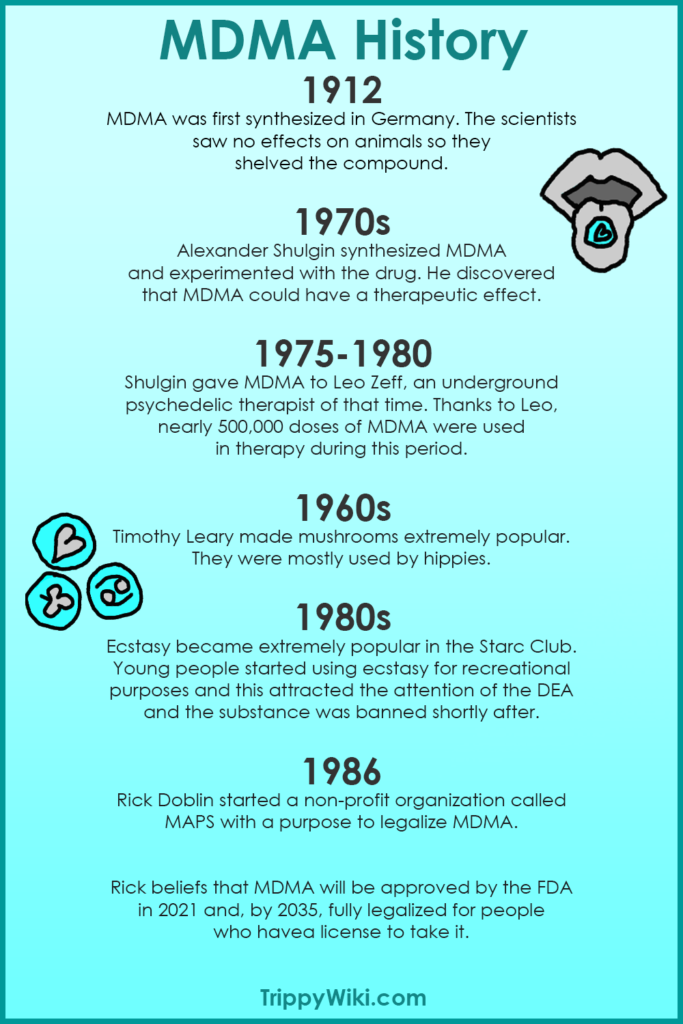
Legality
As of 2021, there is no country where MDMA is legal. The substance is also criminalized in most countries, meaning you can get arrested for owning the substance.
Thanks to Rick Doblin and MAPS, the drug will soon become legal in a therapeutic setting. Rick Doblin estimates that by 2035, everyone who owns a license will be able to legally take MDMA.
Research chemicals that are similar to MDMA are much safer as far as the law goes. In most countries, you can legally buy some of them for chemical purposes.
More on research chemicals below.
Where to get MDMA
These are the ways you can get your hands on the psychedelic, ranked from the safest to the least safe:
Buying chemicals similar to MDMA
Research chemicals, such as 6-APB are similar to MDMA as far as their effects and chemical structure. They are most likely safe but proceed with caution because there isn’t a lot of data about them.
Many of these chemicals are completely legal as long as you buy them for “chemical research” purposes. You cannot consume them legally but whether or not anyone cares is a different story.
Perhaps the best provider of research chemicals is Chemical Collective.
Their products are cheap, the company is extremely reliable and they will deliver the chemicals to you within 20 days. In case the package gets lost, you can ask them to send you a new one and they will.
Some research chemicals may not be legal where you live so always check the legality status for your country before you buy any substance.
If you don’t do that, the police won’t arrest you but you can’t expect to receive the package either.
FAQ
“MDMA, it was beginning to be apparent, could be all things to all people.“
– Alexander Shulgin
You may also like:
Thank you for taking psychedelics responsibly, immature psychonauts are the last thing the psychedelic movement needs.
And thank you for being a part of this renaissance. Together, we can change the world!
